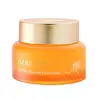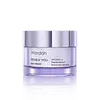What's inside
What's inside
 Key Ingredients
Key Ingredients

 Benefits
Benefits

 Concerns
Concerns

 Ingredients Side-by-side
Ingredients Side-by-side

Water
Skin ConditioningGlycerin
HumectantCyclopentasiloxane
EmollientDimethicone
EmollientButylene Glycol
HumectantNiacinamide
SmoothingPEG-240/Hdi Copolymer Bis-Decyltetradeceth-20 Ether
StabilisingCalendula Officinalis Flower Extract
MaskingSilica
AbrasivePanthenol
Skin ConditioningPalmitoyl Tripeptide-5
Skin ConditioningPalmitoyl Tripeptide-1
Skin ConditioningPalmitoyl Tetrapeptide-7
Skin ConditioningCopper Tripeptide-1
Skin ConditioningAcetyl Hexapeptide-8
HumectantPentylene Glycol
Skin ConditioningAminobutyric Acid
Bis-PEG-18 Methyl Ether Dimethyl Silane
EmollientCaprylyl Glycol
EmollientPolysilicone-11
Raffinose
Skin ConditioningTocopheryl Acetate
AntioxidantPEG-9 Polydimethylsiloxyethyl Dimethicone
EmulsifyingCarbomer
Emulsion StabilisingVinyl Dimethicone/Methicone Silsesquioxane Crosspolymer
Tromethamine
BufferingHydrogenated Lecithin
Emulsifying1,2-Hexanediol
Skin ConditioningGlyceryl Acrylate/Acrylic Acid Copolymer
HumectantDisodium EDTA
Tocopherol
AntioxidantPotassium Laurate
EmulsifyingEthylhexylglycerin
Skin ConditioningColloidal Gold
AntimicrobialAloe Barbadensis Leaf Extract
EmollientPolysorbate 20
EmulsifyingBiotin
AntiseborrhoeicCyanocobalamin
Skin ConditioningAscorbyl Tetraisopalmitate
AntioxidantPyridoxine Hcl
Skin ConditioningLinoleic Acid
CleansingHexylene Glycol
EmulsifyingDecylene Glycol
Skin ConditioningOleic Acid
EmollientTotarol
AntioxidantPalmitic Acid
EmollientStearic Acid
CleansingLinolenic Acid
CleansingPhenoxyethanol
PreservativeWater, Glycerin, Cyclopentasiloxane, Dimethicone, Butylene Glycol, Niacinamide, PEG-240/Hdi Copolymer Bis-Decyltetradeceth-20 Ether, Calendula Officinalis Flower Extract, Silica, Panthenol, Palmitoyl Tripeptide-5, Palmitoyl Tripeptide-1, Palmitoyl Tetrapeptide-7, Copper Tripeptide-1, Acetyl Hexapeptide-8, Pentylene Glycol, Aminobutyric Acid, Bis-PEG-18 Methyl Ether Dimethyl Silane, Caprylyl Glycol, Polysilicone-11, Raffinose, Tocopheryl Acetate, PEG-9 Polydimethylsiloxyethyl Dimethicone, Carbomer, Vinyl Dimethicone/Methicone Silsesquioxane Crosspolymer, Tromethamine, Hydrogenated Lecithin, 1,2-Hexanediol, Glyceryl Acrylate/Acrylic Acid Copolymer, Disodium EDTA, Tocopherol, Potassium Laurate, Ethylhexylglycerin, Colloidal Gold, Aloe Barbadensis Leaf Extract, Polysorbate 20, Biotin, Cyanocobalamin, Ascorbyl Tetraisopalmitate, Pyridoxine Hcl, Linoleic Acid, Hexylene Glycol, Decylene Glycol, Oleic Acid, Totarol, Palmitic Acid, Stearic Acid, Linolenic Acid, Phenoxyethanol
Bakuchiol
AntimicrobialNiacinamide
SmoothingPalmitoyl Pentapeptide-4
Skin ConditioningWater
Skin ConditioningEthylhexyl Methoxycinnamate
UV AbsorberBiosaccharide Gum-1
HumectantPropylene Glycol
Humectant4-Methylbenzylidene Camphor
UV AbsorberCetyl Alcohol
EmollientGlycerin
HumectantGlyceryl Stearate
EmollientPolyacrylamide
Butyl Methoxydibenzoylmethane
UV AbsorberDimethicone
EmollientPhenoxyethanol
PreservativeCyclopentasiloxane
EmollientStearic Acid
CleansingPEG-100 Stearate
Butylene Glycol
HumectantC13-14 Isoparaffin
EmollientHydrolyzed Wheat Protein/Pvp Crosspolymer
Parfum
MaskingLaureth-7
EmulsifyingDimethicone Crosspolymer
Emulsion StabilisingEthylhexylglycerin
Skin ConditioningAllantoin
Skin ConditioningResveratrol
AntioxidantTocopheryl Acetate
AntioxidantDisodium EDTA
Sodium Hyaluronate
HumectantCarbomer
Emulsion StabilisingDimethicone/Vinyl Dimethicone Crosspolymer
Skin ConditioningPolysorbate 20
EmulsifyingPotassium Sorbate
PreservativeEDTA
Dimethiconol
EmollientPalmitoyl Oligopeptide
CleansingPalmitoyl Tetrapeptide-7
Skin ConditioningBakuchiol, Niacinamide, Palmitoyl Pentapeptide-4, Water, Ethylhexyl Methoxycinnamate, Biosaccharide Gum-1, Propylene Glycol, 4-Methylbenzylidene Camphor, Cetyl Alcohol, Glycerin, Glyceryl Stearate, Polyacrylamide, Butyl Methoxydibenzoylmethane, Dimethicone, Phenoxyethanol, Cyclopentasiloxane, Stearic Acid, PEG-100 Stearate, Butylene Glycol, C13-14 Isoparaffin, Hydrolyzed Wheat Protein/Pvp Crosspolymer, Parfum, Laureth-7, Dimethicone Crosspolymer, Ethylhexylglycerin, Allantoin, Resveratrol, Tocopheryl Acetate, Disodium EDTA, Sodium Hyaluronate, Carbomer, Dimethicone/Vinyl Dimethicone Crosspolymer, Polysorbate 20, Potassium Sorbate, EDTA, Dimethiconol, Palmitoyl Oligopeptide, Palmitoyl Tetrapeptide-7
Ingredients Explained
These ingredients are found in both products.
Ingredients higher up in an ingredient list are typically present in a larger amount.
Butylene Glycol (or BG) is used within cosmetic products for a few different reasons:
Overall, Butylene Glycol is a safe and well-rounded ingredient that works well with other ingredients.
Though this ingredient works well with most skin types, some people with sensitive skin may experience a reaction such as allergic rashes, closed comedones, or itchiness.
Learn more about Butylene GlycolCarbomer is a polymer of acrylic acid. Its main role is to create a gel consistency.
A high amount of carbomer can cause pilling or balling up of products. Don't worry, most products contain 1% or less of carbomer.
Cyclopentasiloxane, or D5, is a silicone used to improve texture of products and trap moisture.
D5 is considered lightweight and volatile. Volatile means it evaporates quickly after application. Once evaporated, D5 leaves a thin barrier that helps keep skin hydrated.
It is also an emollient. Emollients help soften the skin and prevent water loss. Silicones create a silky texture in products. D5 helps other ingredients become more spreadable.
Studies show D5 is safe to use in skincare products. We recommend speaking with a skincare professional if you have concerns.
Learn more about CyclopentasiloxaneDimethicone is a type of synthetic silicone created from natural materials such as quartz.
What it does:
Dimethicone comes in different viscosities:
Depending on the viscosity, dimethicone has different properties.
Ingredients lists don't always show which type is used, so we recommend reaching out to the brand if you have questions about the viscosity.
This ingredient is unlikely to cause irritation because it does not get absorbed into skin. However, people with silicone allergies should be careful about using this ingredient.
Note: Dimethicone may contribute to pilling. This is because it is not oil or water soluble, so pilling may occur when layered with products. When mixed with heavy oils in a formula, the outcome is also quite greasy.
Learn more about DimethiconeDisodium EDTA plays a role in making products more stable by aiding other preservatives.
It is a chelating agent, meaning it neutralizes metal ions that may be found in a product.
Disodium EDTA is a salt of edetic acid and is found to be safe in cosmetic ingredients.
Learn more about Disodium EDTAEthylhexylglycerin (we can't pronounce this either) is commonly used as a preservative and skin softener. It is derived from glyceryl.
You might see Ethylhexylglycerin often paired with other preservatives such as phenoxyethanol. Ethylhexylglycerin has been found to increase the effectiveness of these other preservatives.
Glycerin is already naturally found in your skin. It helps moisturize and protect your skin.
A study from 2016 found glycerin to be more effective as a humectant than AHAs and hyaluronic acid.
As a humectant, it helps the skin stay hydrated by pulling moisture to your skin. The low molecular weight of glycerin allows it to pull moisture into the deeper layers of your skin.
Hydrated skin improves your skin barrier; Your skin barrier helps protect against irritants and bacteria.
Glycerin has also been found to have antimicrobial and antiviral properties. Due to these properties, glycerin is often used in wound and burn treatments.
In cosmetics, glycerin is usually derived from plants such as soybean or palm. However, it can also be sourced from animals, such as tallow or animal fat.
This ingredient is organic, colorless, odorless, and non-toxic.
Glycerin is the name for this ingredient in American English. British English uses Glycerol/Glycerine.
Learn more about GlycerinNiacinamide is a multitasking form of vitamin B3 that strengthens the skin barrier, reduces pores and dark spots, regulates oil, and improves signs of aging.
And the best part? It's gentle and well-tolerated by most skin types, including sensitive and reactive skin.
You might have heard of "niacin flush", or the reddening of skin that causes itchiness. Niacinamide has not been found to cause this.
In very rare cases, some individuals may not be able to tolerate niacinamide at all or experience an allergic reaction to it.
If you are experiencing flaking, irritation, and dryness with this ingredient, be sure to double check all your products as this ingredient can be found in all categories of skincare.
When incorporating niacinamide into your routine, look out for concentration amounts. Typically, 5% niacinamide provides benefits such as fading dark spots. However, if you have sensitive skin, it is better to begin with a smaller concentration.
When you apply niacinamide to your skin, your body converts it into nicotinamide adenine dinucleotide (NAD). NAD is an essential coenzyme that is already found in your cells as "fuel" and powers countless biological processes.
In your skin, NAD helps repair cell damage, produce new healthy cells, support collagen production, strengthen the skin barrier, and fight environmental stressors (like UV and pollution).
Our natural NAD levels start to decline with age, leading to slower skin repair, visible aging, and a weaker skin barrier. By providing your skin niacinamide, you're recharging your skin's NAD levels. This leads to stronger, healthier, and younger looking skin.
Another name for vitamin B3 is nicotinamide. This vitamin is water-soluble and our bodies don't store it. We obtain Vitamin B3 from either food or skincare. Meat, fish, wheat, yeast, and leafy greens contain vitamin B3.
The type of niacinamide used in skincare is synthetically created.
Learn more about NiacinamidePalmitoyl Tetrapeptide-7 (formerly Palmitoyl Tetrapeptide-3) is a lab-made peptide with anti-inflammatory and skin-repairing benefits. It's made up of four amino acids (glycine, glutamine, proline, and arginine) and palmitic acid (which helps it penetrate skin more effectively).
This ingredient helps reduce inflammation by limiting the production of interleukin-6 (IL-6), a chemical that triggers inflammatory responses, particularly after UV exposure.
Less inflammation = slower collagen breakdown and a longer-lasting, youthful appearance.
Palmitoyl Tetrapeptide-7 also stimulates collagen production and supports a healthier skin barrier.
Over time, this can improve skin firmness, hydration, and reduce the appearance of fine lines. It’s commonly paired with Palmitoyl Tripeptide-1 in the well-known Matrixyl 3000 complex for enhanced anti-aging effects.
This ingredient has been shown to be effective and safe in cosmetic use and you'll typically find it in small amounts (less than 0.01%).
Due to its palmitic acid base, it may not be safe for Malassezia folliculitis.
Read more about other common types of peptides here:
Learn more about Palmitoyl Tetrapeptide-7Phenoxyethanol is a preservative that has germicide, antimicrobial, and aromatic properties. Studies show that phenoxyethanol can prevent microbial growth. By itself, it has a scent that is similar to that of a rose.
It's often used in formulations along with Caprylyl Glycol to preserve the shelf life of products.
Polysorbate 20 is made by combining ethoxylation of sorbitan, ethylene oxide, and lauric acid. It is a mild cleansing agent, surfactant, and emulsifier.
As a surfactant, it helps collect dirt and oils for washing. Emulsifiers prevent oils and water from separating.
Polysorbate 20 also adds scent to a product. Since it is made using sorbitol, it has a sweet scent. Sorbitol can also be found in fruits such as apples and peaches.
The lauric acid used to create Polysorbate 20 is often derived from coconuts.
Polysorbate 20 may not be fungal acne safe.
Learn more about Polysorbate 20Stearic Acid is a fatty acid. It is an emollient, emulsifier, and texture enhancer.
As an emollient, stearic acid helps soften skin. It aids the skin's protective barrier by preventing water loss. It also provides a gentle cleansing effect without stripping away natural oils.
Stearic acid may also be used to enhance the texture of products. It can add volume and stabilize ingredients such as water and oil. This can help water and oil ingredients from separating.
Sources of stearic acid include animal or vegetable fats/oils such as coconut or shea. It can be naturally found in butter, cocoa butter, shea butter, vegetable fats, and animal tallow.
This ingredient may not be Malassezia folliculitis, or fungal-acne safe.
Learn more about Stearic AcidTocopheryl Acetate is AKA Vitamin E. It is an antioxidant and protects your skin from free radicals. Free radicals damage the skin by breaking down collagen.
One study found using Tocopheryl Acetate with Vitamin C decreased the number of sunburned cells.
Tocopheryl Acetate is commonly found in both skincare and dietary supplements.
Learn more about Tocopheryl AcetateWater. It's the most common cosmetic ingredient of all. You'll usually see it at the top of ingredient lists, meaning that it makes up the largest part of the product.
So why is it so popular? Water most often acts as a solvent - this means that it helps dissolve other ingredients into the formulation.
You'll also recognize water as that liquid we all need to stay alive. If you see this, drink a glass of water. Stay hydrated!
Learn more about Water